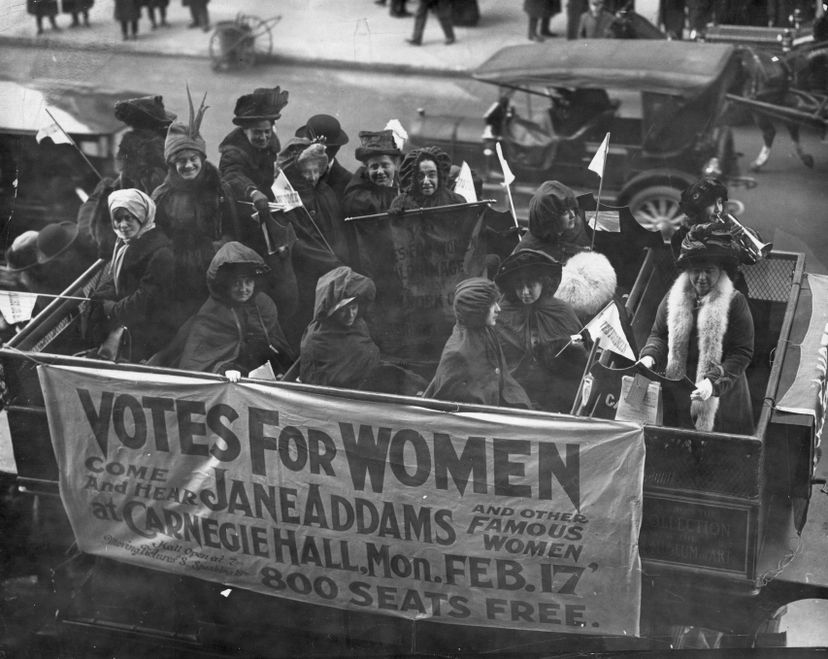
About This Quiz
How much do you know about the remarkable people that fought discrimination against women and advocated the political, economic and social equality of women and men? Take our quiz to pay homage to the great suffragists of the women's rights movement!Women were not allowed to vote in national elections in the United States until 1920.
The First Women's Rights Convention was held at the Wesleyan Chapel in Seneca Falls, New York, on July 19 and 20, 1848.
The principal organizers of the Seneca Falls Convention were Elizabeth Cady Stanton, a mother of four from upstate New York, and the Quaker abolitionist Lucretia Mott.
Advertisement
Elizabeth Stanton and Susan B. Anthony created the National Woman Suffrage Association, which directed its efforts toward changing federal law and opposing the 15th Amendment because it excluded women.
Lucy Stone, a Massachusetts anti-slavery advocate and a prominent lobbyist for women's rights, formed the American Woman Suffrage Association.
The two groups merged to form the National American Woman Suffrage Association.
Advertisement
Elizabeth Cady Stanton became the president of the National American Woman Suffrage Association in 1890.
Alice Paul formed the National Woman's Party and adopted the more militant tactics of its English counterparts, picketing and conducting mass rallies and marches to raise public awareness and support.
During World War I most suffragettes stopped the women's rights campaign to support the war effort.
Advertisement
Demanding the right to vote for all women was considered totally radical at the 1848 convention.
The first state to grant women complete voting rights was Wyoming in 1869.
In 1913 Illinois finally allowed women the right to vote. Most states east of the Mississippi didn't give women the right to vote until the federal constitutional amendment.
Advertisement
Rankin was sworn into the 65th Congress on April 2, 1917, two years after Montana gave women the right to vote.
The House of Representatives initially passed a voting rights amendment on January 10, 1918, but the Senate did not follow suit before the end of the 65th Congress.
Hattie Caraway was elected to the Senate in January 1932. Rebecca Latimer Felton was the first woman to serve in the Senate, but she was appointed and not elected.
Advertisement
The suffragettes used white, purple and gold as symbols of their campaign.
Picketers led by Alice Paul were arrested at the White House on a trumped-up charge of obstructing traffic, and they were jailed when they refused to pay the imposed fines. Despite the danger of bodily harm and imprisonment, the suffragists continued their demonstrations.
The arrested suffragists were sent to Occoquan Workhouse, a prison in Virginia. Paul and the other women followed the English suffragette model and demanded to be treated as political prisoners and staged hunger strikes. They were beaten, pushed and thrown into cold, unsanitary, rat-infested cells.
Advertisement
Susan B. Anthony and Elizabeth Cady Stanton created The Revolution, the women's rights weekly newspaper published between Jan. 8, 1868 and Feb. 17, 1872.
In the presidential election of 1872, Susan B. Anthony and 14 other women registered to vote in Rochester, New York, then went to the polling place to vote on November 5. All 15 were arrested, along with the registrars.
Charlotte Woodward was the only woman who attended the 1848 Seneca Falls Convention who was alive in 1920 and eligible to vote. She was too sick to vote, however.
Advertisement
Senator Aaron Sargent introduced a joint resolution proposing an amendment that would enfranchise women on Jan. 10, 1878. He was also good friends with both Elizabeth Cady Stanton and Susan B. Anthony.
One of the strongest voices for abolitionism, Frederick Douglass worked for woman's suffrage throughout his life and even gave a speech at a women's rights conference on the day he died in 1895.
Pillsbury helped draft the constitution of the feminist American Equal Rights Association in 1865, served as vice president of the New Hampshire Woman Suffrage Association, and was co-editor of the newspaper The Revolution in 1868.
Advertisement
Passed by Congress on June 4, 1919, and ratified on Aug. 18, 1920, the 19th amendment guarantees all American women the right to vote.
The Equal Rights Amendment was written in 1923 by Alice Paul, leader and founder of the National Woman's Party.Â
The main premise of the ERA states, "Equality of rights under the law shall not be denied or abridged by the United States or by any state on account of sex."
Advertisement
The seven-year time limit in the ERA's proposing clause was extended by Congress to June 30, 1982, but at the deadline, the ERA had been ratified by 35 states, leaving it three states short of the 38 required for ratification.
Meryl Streep, who starred as British suffragette leader Emmeline Pankhurst in the film "Suffragette," sent all 535 members of Congress a letter urging them to bring back the Equal Rights Amendment in order to finally ratify it into the Constitution.
The original amendment read, "Men and women shall have equal rights throughout the united states and every place subject to its jurisdiction."
Advertisement